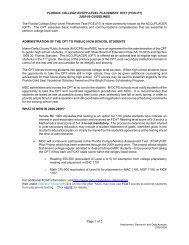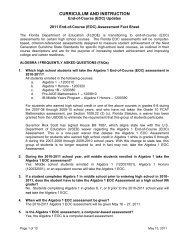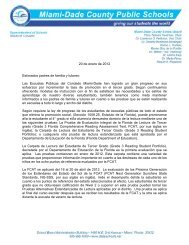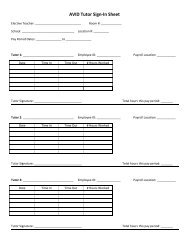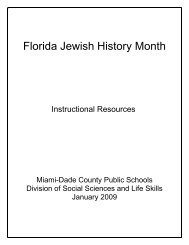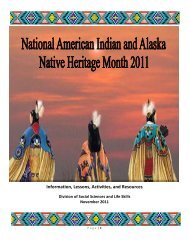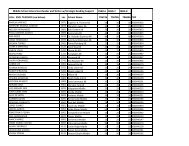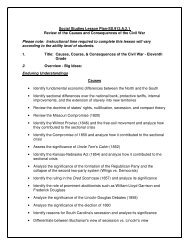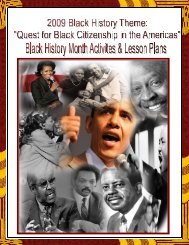Lessons Activities and Resources to Support the Commemoration of Veterans Day
Lessons, Activities and Resources to Support the Commemoration ...
Lessons, Activities and Resources to Support the Commemoration ...
- No tags were found...
You also want an ePaper? Increase the reach of your titles
YUMPU automatically turns print PDFs into web optimized ePapers that Google loves.
WOMEN ARE VETERANS TOO!<br />
Did you know that <strong>the</strong>re are almost two million women veterans? From <strong>the</strong> American<br />
Revolution <strong>to</strong> Panama, Bosnia, Kosovo, Afghanistan <strong>and</strong> Iraq, women have served in<br />
some way in every conflict. Women may not have been legal participants in <strong>the</strong> early<br />
days, but many did <strong>the</strong>ir part <strong>to</strong> support <strong>the</strong> cause.<br />
During <strong>the</strong> American Revolution, although <strong>the</strong> call <strong>to</strong> arms was for men, several women<br />
donned <strong>the</strong> uniform <strong>of</strong> <strong>the</strong> revolutionary solider <strong>and</strong> fought against <strong>the</strong> British. One <strong>of</strong><br />
<strong>the</strong>se women was Deborah Samson who, in Oc<strong>to</strong>ber <strong>of</strong> 1778, disguised herself as a<br />
young man <strong>and</strong> presented herself <strong>to</strong> <strong>the</strong> American army as a volunteer. She served,<br />
undetected for three years under <strong>the</strong> name <strong>of</strong> Robert Shirtliffe. Even though she was<br />
wounded twice her identity was not revealed until she came down with “brain fever” a<br />
common ailment among soldiers at that time.<br />
O<strong>the</strong>r women <strong>of</strong> <strong>the</strong> Revolution, like Anna Warner, wife <strong>of</strong> Captain Elijah Bailey, earned<br />
<strong>the</strong> tile <strong>of</strong> “The Heroine <strong>of</strong> Gro<strong>to</strong>n” because <strong>of</strong> her fearless efforts <strong>to</strong> aid <strong>the</strong> wounded<br />
during <strong>the</strong> massacre at Fort Griswald in Connecticut. There is <strong>the</strong> little known s<strong>to</strong>ry <strong>of</strong><br />
Rachel <strong>and</strong> Grace Martin who disguised <strong>the</strong>mselves as men <strong>and</strong> assailed a British<br />
courier <strong>and</strong> his guards, stealing important strategic documents which <strong>the</strong>y turned over<br />
<strong>to</strong> <strong>the</strong> American General Nathaniel Greene.<br />
The War Between <strong>the</strong> States was also a war between bro<strong>the</strong>rs, cousins, friends <strong>and</strong><br />
neighbors – <strong>and</strong> some <strong>of</strong> <strong>the</strong>m were women. Women served as viv<strong>and</strong>ieres, (women<br />
who provided food, provisions, <strong>and</strong> liqueurs <strong>to</strong> soldiers), sutlers, (peddlers who sold<br />
goods <strong>to</strong> military units in <strong>the</strong> field), nurses, soldiers <strong>and</strong> even spies. Susie Baker, born a<br />
slave in Georgia, not only helped members <strong>of</strong> <strong>the</strong> 33 rd U.S. Colored Troops learn <strong>to</strong><br />
read <strong>and</strong> write, she also cleaned, loaded <strong>and</strong> fired a musket when necessary. His<strong>to</strong>rical<br />
records verify that over eighty women were ei<strong>the</strong>r wounded or killed at various battles in<br />
<strong>the</strong> Civil War on both sides, not counting <strong>the</strong> thous<strong>and</strong>s who served as nurses. One<br />
woman, Dr. Mary Walker, a surgeon in <strong>the</strong> Civil War, was awarded The Medal <strong>of</strong> Honor<br />
by President Andrew Johnson.<br />
Prior <strong>to</strong> World War I, many women disguised <strong>the</strong>ir identity in order <strong>to</strong> participate in <strong>the</strong><br />
armed services; o<strong>the</strong>rs worked in more traditional support roles. During <strong>the</strong> war <strong>of</strong><br />
1812, a U. S. Marine, served aboard <strong>the</strong> USS Constitution under <strong>the</strong> name George<br />
Baker. Baker was in fact Lucy Brewster, a farm girl from Massachusetts who is<br />
recognized as <strong>the</strong> first woman Marine. In <strong>the</strong> Mexican War <strong>of</strong> 1846, Sarah Borginis<br />
enlisted in<strong>to</strong> <strong>the</strong> 8 th Calvary with her husb<strong>and</strong>. Borginis not only became <strong>the</strong> unit’s<br />
principal cook, she also <strong>to</strong>ok an active part in <strong>the</strong> battle at Fort Brown. As a result <strong>of</strong> her<br />
actions, General Zachary Taylor brevetted (gave her a promotion without an increase in<br />
pay) her <strong>to</strong> colonel, making her <strong>the</strong> first female colonel <strong>of</strong> <strong>the</strong> U.S. Army.<br />
More than 1500 women served in <strong>the</strong> U.S., overseas <strong>and</strong> aboard hospital ships during<br />
<strong>the</strong> Spanish American War. They were recruited <strong>to</strong> serve as civilian nurses under<br />
contract with <strong>the</strong> U.S. Army – for thirty dollars a month. The Army <strong>and</strong> Navy Nurse<br />
Corps were established in 1901 <strong>and</strong> 1908. These were <strong>the</strong> first women in <strong>the</strong> country <strong>to</strong><br />
be admitted <strong>to</strong> military rank <strong>and</strong> status.



